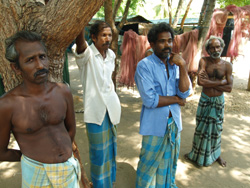Half a Million People Could Be Affected by Conflict in 2008
by IRIN Humanitarian News and Analysis, February 26, 2008
|
Use the link below to read CHAP report, which contains much useful information. -- Ed. Comm.
|
COLOMBO, 25 February 2008 (IRIN) - The UN and NGOs working in the conflict-ridden north and east are warning of a mounting humanitarian toll in 2008 due to the escalation in hostilities between Sri Lankan government forces and the Liberation Tigers of Tamil Eelam (LTTE).
Agencies should be prepared to assist “up to 500,000 conflict-affected individuals comprising IDPs, returnees and economically affected persons”, according to the Common Humanitarian Action Plan (CHAP) 2008, prepared by the Inter Agency Standing Committee (IASC) country team for Sri Lanka and released on 22 February.
“The CHAP is based on the assumption that as the government acts on its stated intention to disarm the LTTE, the conflict in Sri Lanka will continue and intensify,” the report stated. “Even if it were to slow down or end during the year, there would remain very significant humanitarian needs to be met in the areas of conflict.”
The report warned that displacement levels could be similar to 2007 when 308,000 persons were forced from their homes. More than 140,000 have now been resettled in eastern Sri Lanka, but as of mid-February, 225,000 people remained displaced in eight north and eastern districts.
 |
| IDPs at the Nanthurai welfare camp in Jaffna town. As of mid-February, 225,000 people remained displaced in eight north and eastern districts |
The main areas of assistance identified in the CHAP are protection, shelter, food, water and environmental sanitation (WASH), food aid, nutrition, health, education, food security (including agriculture and fisheries), economic recovery and infrastructure, and logistics. The CHAP report states that of the US$175.4 million required for 2008, $29.2 million has been committed by donors.
"The humanitarian community is operating under extremely difficult circumstances, which have affected its ability to reach as many people as need support,” the report stated. In some areas of the north access is near impossible.
Since December 2007, when the Tamil Tigers informed UN and other agencies working in the northern Mullaitivu District under their control that they could not guarantee their safety, agencies have downsized, with limited numbers of staff returning only during daylight hours, Mullaitivu government agent, Imalda Sukumar, told IRIN.
“No one [UN or other relief agency staff] stays here in Mullaitivu … everybody leaves by late afternoon,” Sukumar said, adding, “Obviously there are delays in programme implementation and assistance.”
Humanitarian agencies are finding it increasingly difficult to transport assistance into Tiger-held areas beyond Vavuniya, the last government-held town before Tiger-controlled areas 220km north of the capital, Colombo. All goods and vehicles undergo stringent government checks at Madavachchiya town, 30km south of Vavuniya.
Barriers
To facilitate its own food distribution activities in the north and to assist other agencies with transport and storage of their own relief goods, the World Food Programme (WFP) has been providing a fleet of trucks for transport and established logistical hubs and storage facilities just south of the line marking Tamil Tiger-controlled areas.
Mohamed Saleheen, WFP country head in Sri Lanka, told IRIN it was critical given the escalating food needs in the north to pre-position food supplies in Vavuniya to avoid pipeline breaks. He also cautioned that as demand increased, WFP would need additional funding to purchase food and maintain storage and logistical capacity.
CARE International is one such agency that depends on the WFP storage facilities and trucks to move supplies to LTTE-held areas. “It is vital now that the WFP operations continue,” Nick Osborne, CARE country head, told IRIN. “There are so many issues related to the transportation of goods and it's easier to do that through one agency.”
However, he warned about increasing barriers to distribution. “There are all kinds of restrictions and checking on goods being transported to areas under the Tigers,” he told IRIN.
On 12 February, the Sri Lankan Army introduced new procedures for allowing vehicles into Vavuniya from Vanni (Tiger-held areas), according to the IASC. “This new directive permits only seven light vehicles and seven trucks per day,” it stated.
The Sri Lankan military said the delay was due to a lack of technical staff to man the checkpoints. “It is because of lack of personnel and we are working to get more people to the checkpoints and soon the restriction can be eased,” a military spokesman, Brig Udaya Nanayakkara, told IRIN.
However, the situation is unlikely to improve significantly soon, as the CHAP report warned. “Since the CHAP was drafted at the end of 2007, the best-case scenario, which included cessation of violence, implementation of the CFA [ceasefire agreement] and no new internal displacements, can no longer be viewed as a realistic option, at least during the first part of 2008,” it stated. “Indeed, the first month of 2008 witnessed an escalation of fighting along the FDL [forward defence line], several devastating Claymore attacks and growing insecurity inside and out of the conflict areas.”
|
 Home
Home Archives
Archives